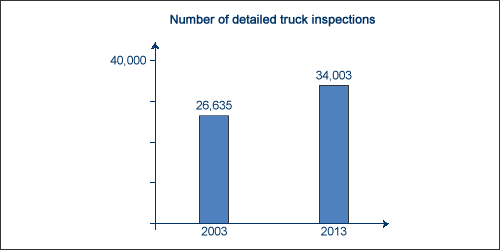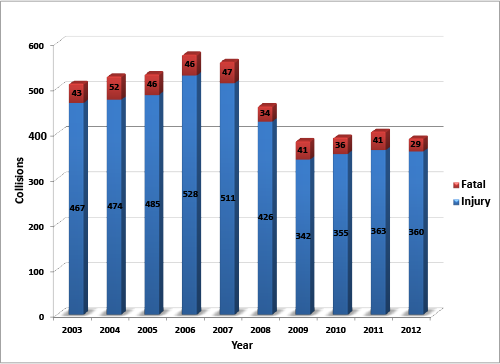Key Facts
The British Columbia Ministry of Transportation and Infrastructure Commercial Vehicle Safety and Enforcement (CVSE) branch promotes compliance of safety regulations within the commercial transport sector, with the goal of increasing road safety and protecting public health, the environment and transportation infrastructure.
Within the commercial transport sector, heavy commercial trucks are a large focus of the CVSE:
- A heavy commercial truck is classified as a vehicle weighing more than 11,795kg which is an internationally recognized minimum weight for commercial heavy vehicles;
- This category of truck includes dump trucks, tractor trailers, logging trucks etc which typically require the operator to have professional training and a specialized license;
- Trucks in the lower weight category of 5,000-11,794kg include 1 ton pickups, delivery vehicles, service vehicles etc.
- From 2003 to 2013, the number of heavy commercial trucks registered in B.C. has increased 25%, from 49,130 to 61,310*.

* Based on ICBC data
History of CVSE
CVSE began in 1958 as the B.C. Department of Commercial Transport and became responsible for 15 fixed scale facilities and six portable patrol vehicles. Since that time, the branch as grown and positions developed:
- In 2003 there were 283 positions when CVSE transferred from ICBC to the Ministry of Transportation and Infrastructure;
- And in 2014, there are 286 positions in CVSE.
Breakdown of positions within CVSE from 2003 - 2014
2003 |
2014 |
|---|---|
283 Total Positions in CVSE |
286 Total Positions in CVSE |
82 Mobile Inspectors** |
180 Mobile Inspectors** |
145 Stationary Inspectors |
34 Stationary Inspectors |
17 Managers |
16 Managers |
38 Clerical and Support |
54 Permit Processing, Clerical and Support |
1 Engineer |
2 Engineers |
**Mobile Inspectors include Carrier Safety Inspectors and Mechanical Vehicle Inspectors |
|
Mobile Inspection Vehicles, Weigh-in-Motion Stations, Pullouts and Weigh Scales
- In 2003 CVSE had 88 mobile inspection vehicles, as of 2014 there are 121;
- In 2003 there were no weigh-in-motion stations, as of 2014 there are three weigh-in-motion stations and six other stations in the Weigh2GoBC program that can do automatic vehicle identifications;
- In 2003 there were no established pullouts for conducting mobile inspections, as of 2014 there are 49;
- In 2005, CVSE had 35 permanent weigh scale locations, as of 2014 there are 30
.
Permits and Inspections Progress
- In 2003, CVSE stationary inspectors spent on average 20-30% of their workday issuing commercial vehicle permits, leaving inspectors less time to focus on inspection issues.
- In 2005 a Provincial Permit Centre was established, consolidating all provincial permit applications into one location;
- Additionally, in 2008 an online permit system was created allowing permit applications to be processed over the internet (prior to the online system, all permits were processed manually);
- In 2014, there are 18 staff solely dedicated to processing permits and managing the online site within the Provincial Permit Centre
- These improvements allow stationary inspectors to focus almost all of their time on commercial vehicle safety and has allowed additional mobile inspector positions to be created.
- With almost double the number of mobile inspectors and one-third more inspection vehicles since 2003, CVSE inspectors now have the flexibility to work at either a stationary scale or travel the province to inspect heavy trucks throughout the highway system instead of at fixed locations only;
- Furthermore, in 2005 the province authorized mobile inspectors to conduct speed enforcement for heavy trucks to enhance safety on B.C.’s highway system;
- And, with the new weigh-in-motion stations, which allow the weighing of trucks while travelling the highway, inspectors have more time to inspect the trucks that require further investigation.
Inspection Levels
- The number of detailed truck inspections increased from 26,635 in 2003 to 34,003 in 2013, an increase of 27%.
Safety and Enforcement
CVSE officers conduct more than 30,000 vehicle inspections each year, issuing violation tickets and removing unsafe vehicles from the provincial roadways on a daily basis. Their focus is on the safe and efficient movement of people and goods in B.C.
- Truck safety is improving on our provincial highway network as demonstrated by a 24% reduction in truck collisions involving injuries and fatalities on B.C.’s highways, since 2003.*

* Data from the Ministry of Transportation and Infrastructure
Collision Information System
B.C. Heavy Truck Collision Statistics
Here are some factors to consider when looking at B.C. heavy commercial truck collision statistics:
- Collision data collection is the responsibility of ICBC. ICBC focuses on broader collision data collected from both municipal roadways and the provincial highway network. This data includes all police and non-police attended collisions.
- B.C. Ministry of Transportation and Infrastructure’s Collision Information System receives collision data from ICBC. When analyzing heavy truck collision data, this Collision Information System focuses on collisions on the provincial highway network that are attended by the police. Information collected by the police improves data collection consistency and reliability. This Collision Information System data works as a reliable ministry resource for statistics that represent CVSE influence on commercial vehicle safety.



